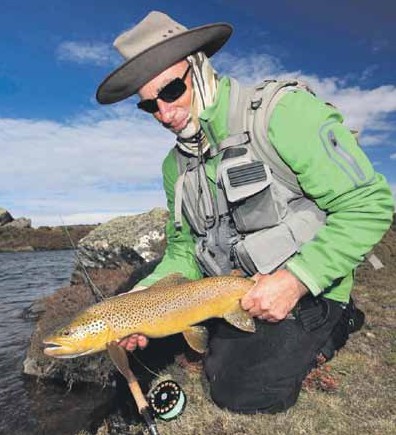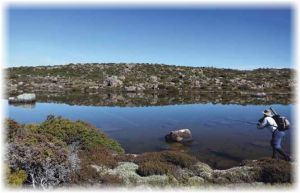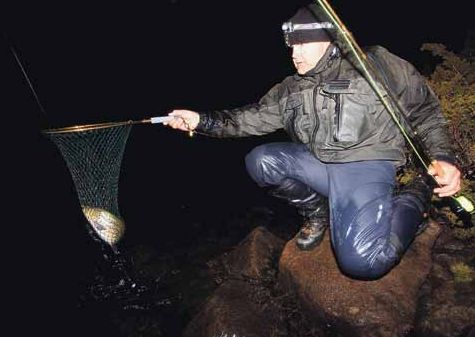From the Archives ...
Sea Run Trout
Mid Sea-Run Season Report
Sea-run trout fishing this year got off to a cracking start in most areas, with the majority of anglers employing nearly every trout fishing technique to secure fish in local estuaries statewide.
Even those anglers fishing the "off-season" lower down in our estuaries for sea-trout commented on the number of fish moving in early August.
 Presented from Issue 117, August 2015
Presented from Issue 117, August 2015
Dry fly or wet fly
I like catching fish on a dry fly just as much as the next person and will often persist with floating flies early in the season, experimenting to try for a response, . I know that I will get refusals and catch less doing this, but for me this is not a numbers game.
Success or failure with any fly can vary from water to water in the Western Lakes, as each location can be vastly different from the next. What fish feed on can change from lake to lake or from shore to shore depending on the make up of each lake, the food within it and the effects of rising or falling water levels. The trick is to find a fly and technique that will trigger a response from them more often than not. Sometimes it comes down to finding a single fish that is willing to take a chance and open and close its mouth onto a fly that vaguely resembles a potential feed.
- Written by Stephen Smith - Rubicon Web and Technology Training
- Category: Western Lakes
- Hits: 3295
 Presented from Issue 108, February 2014
Presented from Issue 108, February 2014
One of Tasmania’s most experienced Western Lakes anglers, Craig Rist, explains what’s in his day pack and why.
What to pack for a day out West is something I consider very carefully through out the season. The time of year and the expected weather conditions for a particular day will dictate what I throw into my pack. How many kilometres I expect to walk into the heart of the Western Lakes, away from civilization, is another factor I consider, especially if it’s going to be a solo trip and you don’t have anyone to help you limp out with a broken or sprained ankle.
- Written by Stephen Smith - Rubicon Web and Technology Training
- Category: Western Lakes
- Hits: 6833
Read more: Western walk - What to take for the day - Craig Rist
Presented from Issue 104, June 2013
Macca and I were kicking back in my tying room in early January this year tying a few flies, having a beer and talking about the seasons exploits. He was filling my head with stories of his Western Lakes adventures and big golden brown trout. Eventually I couldn’t stand it any longer, the images that were being painted in my head became unbearable.
It had been mid-December since I had been to the Julian Lakes area on a three day mission and I just had to get fishing again. Doing my best to sound polite I said “Macca please shut up with all the stories old pal its killing me, lets just get a trip organised and get out West to polaroid some of those trophy browns”. He didn’t take a whole lot of convincing that it was a good idea, so first things first we got the calendar out to settle on some dates that would work for both of us. Sounds easy, but I can assure you when both parties work and you factor in family, sport etc. it’s not always so.
- Written by Stephen Smith - Rubicon Web and Technology Training
- Category: Western Lakes
- Hits: 4958
Presented from Issue 100
For adventurous trout anglers springtime and early summer is the time to start thinking about heading out to the area officially known as the Central Plateau Conservation Area or simply to most of us as the Western Lakes.
This area boasts world class angling opportunities in rugged wilderness setting. For many fishermen their sole exposure to the western lakes region is the pocket of waters in the eastern edge of the CPCA known as the “19 Lagoons”. While these lakes and lagoons always provide reliable fishing opportunities, in this modern age it is hard to get a water or even a short section of shoreline to yourself particularly if you are restricted to weekend trips. For those of us seeking solitude and also adventure, venturing further out into the wilderness is a must.
Simon Tueon (Chewy) and I recently shared one such adventure in to this magnificent wilderness fishery. Here is our story….
- Written by Stephen Smith - Rubicon Web and Technology Training
- Category: Western Lakes
- Hits: 5955
 Presented from Issue 99
Presented from Issue 99
The Western Lakes can be a tough place to catch a fish, especially if you’re limiting yourself to sight fishing only. There are many influencing factors that can contribute to seeing very few fish during the day. We see fish in the shallows because there is often some kind of food present that brings them in close to shore. So if there is no food, they really have no reason to leave the security and food rich environment of the deeper water. During low water levels and high water temperatures in late summer, trout will often shelter under rocks during the heat of the day and only venture out late in the evening and into the night to feed. These are the days when you can walk all day and only seen one or two fish.
- Written by Stephen Smith - Rubicon Web and Technology Training
- Category: Western Lakes
- Hits: 5829
Presented from Issue 97
When people refer to the Western Lakes they are talking about a vast area of the central plateau that contains hundreds if not thousands of lakes. This area is made up of the central plateau conservation area and the Walls of Jerusalem National Park. This area and its fishing is truly unique in the world. The crystal clear waters and the ability to sight fish predominantly brown trout, at close range, amongst a unique landscape, is something that inspires many people to go to great lengths to explore and fish this region. Interestingly, the Western Lakes is not a place where you would go to catch a lot of fish in Tasmania. This is a place where less is more, with the ability to catch a large number of fish per day being gladly replaced with the chance of only catching a few quality fish. This is a place where there is a lake over every hill and where you get that rare opportunity to count the spots on a wild brown trout as it slowly swims past your feet.
- Written by Stephen Smith - Rubicon Web and Technology Training
- Category: Western Lakes
- Hits: 5365
- Written by Stephen Smith - Rubicon Web and Technology Training
- Category: Western Lakes
- Hits: 8724
 Western Lakes
Western Lakes
There’s a lot I could say about the attached photo! I could say it took us days of scrub bashing, boulder climbing, hard slog bushwalking to reach this remote shallow body of crystal clear water, located somewhere in Tasmania’s Western Lakes wilderness fishery. But really, it wasn’t too far to walk and the going wasn’t that tough. It was definitely worth the effort to get there and the rewards were so much sweeter.
- Category: Western Lakes
- Hits: 7739
Western Wilderness fishing
Shane Flude
I started bushwalking a few years before I started fishing in earnest so it is only natural that I later combined the two and began to explore Tasmania's Western Lakes. One of the first trips I did and one which I have done again recently was the Pine Valley and its associated lakes and tarns. Despite visiting this area several times, I still find it has everything to offer the bushwalking/fishing enthusiast and its somewhere I will probably visit until I'm too old to do so comfortably. It features a number of waters that mostly contain high numbers of moderate sized trout and several nearby trophy waters for the occasional monster. The area is easy to walk through, has tracks leading in from both ends to the valley and the headwaters rise in what would have to be one of Tasmania's most scenic areas, the Walls of Jerusalem National Park.
- Category: Western Lakes
- Hits: 12864
Tasmania's Western Lakes
Shane Flude
The Western Lakes is the term given to the huge area of lakes and tarns in the Central Highlands of Tasmania. The area is roughly bordered by Great Lake in the east, Lake Rowallan in the West and Lake Mackenzie to the north. The lakes are typically very shallow and clear on the upper plateau from the Pine Valley north. Further south and west the waters are relatively deep with well defined rocky shorelines. The western lakes are truly a world class fishery unique to Tasmania.
- Category: Western Lakes
- Hits: 33049
Current TFBN
Click above for current issue content. The current issue of TFBN is extensive and topical. In Tackle Stores, Newsagents and by subscription.
Delivered to your door for $48 for 2 years (8 issues). To subscribe, send Mike $48 via www.paypal.com.au . (Basic instructions are here) The email is at Contact Us. Your address will be included from PayPal.
Or phone Mike with your c/c handy on 0418129949
Please ensure your details are correct, for Mike to organise delivery.
TFBN Newsletter Sign up Form
Why not submit an article ?
When you have finished for the day, why not have a brag about the ones that didn't get away! Send Mike an article on your fishing (Click here for contact details), and we'll get it published here. Have fun fishing - tasfish.com
Category Descriptions
Here is a list of all of the Article Categories. The number in Brackets, eg (13) is the number of articles. Click on Derwent River and all articles relating to the Derwent will be displayed in the central area.
Articles by Category
-
Rivers (3)
-
Saltwater and Estuary Fishing (149)
-
Kayak Fishing (34)
-
Lakes (1)
-
Great Lake (62)
-
Lake Leake (52)
-
Woods Lake (16)
-
Lake Augusta (11)
-
Huntsman Lake (13)
-
Lake Pedder and Gordon (10)
-
Lake Dulverton (5)
-
Lake Crescent (6)
-
Tooms Lake (10)
-
Lake Mackintosh (2)
-
Lake Barrington (5)
-
Little Lake (8)
-
Meadowbank Lake (5)
-
Lake King William (7)
-
Lake St Clair (2)
-
Western Lakes (12)
-
Arthurs Lake (35)
-
Lake Echo (7)
-
Four Springs (54)
-
Lake Sorell (7)
-
Lake Burbury (6)
-
Other Lakes (57)
-
Brushy Lagoon (18)
-
Little Pine Lagoon (5)
-
Penstock Lagoon (16)
-
Brumbys Creek (7)
-
-
Events (48)
-
Estuary Fishing (0)
-
Coastal Catches (46)
-
Super Trawler (46)
-
IFS, DPIPWE, MAST and Peak Bodies (435)
-
Commercial Interests (98)
-
Other (24)
-
TFBN Back Issues (8)
-
Fly Fishing (67)
-
Trout Fishing (250)
-
Meteorology and Weather (8)
-
Jan’s Flies (50)
-
Tuna Fishing and other Game Fishing (86)
-
Cooking Fish (19)
-
Fishing Information (1)
-
Fishing Books (8)
-
Videos (5)
-
Tackle, Boats and other Equipment (146)
-
World Fly Fishing Championship 2019 (2)
Popular Tags
windyty.com
Visit https://www.windyty.com/
Rubicon Web and Technology Training
Hello everyone, I thought it would be a good time to introduce myself.
My name is Stephen Smith and I have been managing the website tasfish.com since May 2009.
It has been an epic journey of learning and discovery and I am indebted to Mike Stevens for his help, support and patience.
I am developing a new venture Rubicon Web and Technology Training ( www.rwtt.com.au ). The focus is two part, to develop websites for individuals and small business and to train people to effectively use technology in their everyday lives.
Please contact me via www.rwtt.com.au/contact-me/ for further information - Stephen Smith.
From the Archives ... (last chance)
Atlantic Salmon At Large
Atlantic Salmon At Large
Recently Atlantic salmon seems to be a very hot topic amongst local anglers, especially those in the south of the state in the D'Entrecasteaux area. Northern anglers should take a close look at the Tamar as there are opportunities here as well.
The recent "great escape" has provided a perfect opportunity for fresh and saltwater anglers alike to experience some truly memorable sport. Tasmania's pristine, clean and cool waters are the perfect nursery for the Atlantic Salmon and as our local fish farms produce more and more fresh quality seafood it is a fact that there are going to be tangible consequences.



